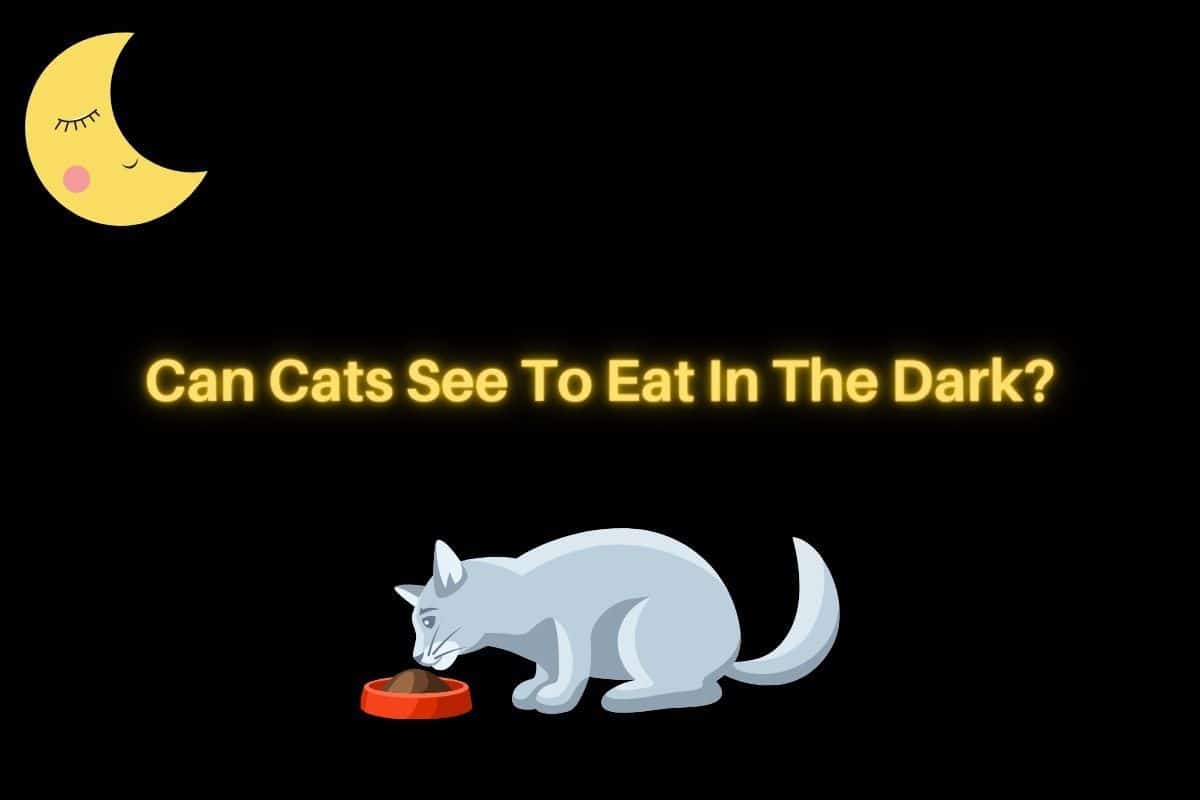Cats are marvelous and magical creatures, and every cat owner can agree that there is never a dull moment in the presence of a cat. You have also most probably noticed that your cat gets a sudden burst of energy during the nighttime. This makes us wonder, how well can our feline friends see in the dark, and can they see well enough to eat if they get hungry?
Cats can pick up on much more detail in the dark than humans can. As a result, cats can see the shape, texture, and other fine details in the dark where we can’t. Cats are also predatory hunters by their nature, which means their eyes have adapted to hunt at night, as they can see better than their prey.
Continue reading as we discuss whether you should leave your kitty’s food bowl out at night and if you should provide him with a nightlight so that he can eat better!
How Cats See In The Dark
There are several reasons why cats have better night vision than humans and most other animals. It mostly has to do with the structure of their eyes. Following are a small list as to how they have evolved as predators to be able to see in the dark:
- Pupil Shape
Most animals and all humans have circular pupils. Cat’s pupils differ from this, as they have an elliptical, slit-like shape that plays a massive part in how well they can see in the dark.
By comparison to our circular pupils, Elliptical pupils mean that they can push more light into their eyes in the darkness. A cat’s pupils also dilate significantly to allow the most possible light to be let in at nighttime.
- Photoreceptors And Rod To Cone Ratio
All retinas contain two different kinds of photoreceptors, known as rods and cones. Each receptor has a different function within the eye. Rods are responsible for night vision and peripheral vision, while cones are responsible for day vision and the processing of colors.
Cat retinas contain between six to eight times the number of rod cells, which is only one reason why they are so much better at seeing in the dark than humans are. Simply put, cats have a high number of rods and a low number of cones, which is the exact opposite of what we as humans have.
- Cornea Size
The cornea is the outermost layer of the eye. When light enters the eye, it gets bent through the curved edge of the cornea, which plays a huge part in how well the eye can focus on objects.
Cats have a relatively larger cornea size than humans. This is a key contributor to making them able to see and hunt in the dark. In addition, cat’s corneas take over a larger surface area, meaning that their eyeballs are bigger than ours.
Larger corneas mean a larger surface area for light to enter. The more light enters the eye, the easier it is for cats to see and focus on objects in the darkness.
- Tapetum Lucidum
The tapetum lucidum is an additional layer of tissue behind the retina that cats have. Tapetum lucidum is absent in humans, but cats find it very useful. The tapetum of a cat’s eye is that shiny green reflective surface we often see in a cat’s eyes when we see them outdoors at night.
It, therefore, makes sense that cats, which are dusk and dawn hunters, would have the tapetum.
- UV Light Vision
Not only can cats see better than humans, but they can actually see more than us too! For example, cats can see UV light, which allows them to see things like urine trails or patterns that will assist them with their hunting. All these things are invisible to the human eye.
This “superpower” comes from a cat’s ocular media, which is the transparent parts of its eyes. A cat’s ocular media transmits UV wavelengths, which allows more light into the retina.
- Ears And Whiskers
As mentioned, cats can see better than humans in the dark. But, it is not just their eyes that make them adapt better when the sun goes down. A cat’s whiskers also act as touch receptors, which helps them better sense their environment and detect potential obstacles.
Why Are Cats Able To See And Eat In The Dark?
Between their vertical pupils, a relatively high number of rods, large cornea size, and the presence of the tapetum lucidum, it is clear that cats’ eyes are built to see in the dark. But why? And how did cats evolve to see so well in the dark?
Studies have shown that cat’s eyes, more particularly, their pupils, have evolved to make them better night hunters. Studies have also shown that vertical pupils are most common in nocturnal animals, as they use ambush as their primary way of attacking their prey.
Because of the cat’s vertical pupils, they can calculate the precise distance for the best prey-catching leap. Ambush predators, such as cats need to be good at assessing distance to allow them to jump out and catch something moving.
So essentially, your kitty’s vertical pupils not only allow them to see better in the dark but also allow them to get a better sense of precisely where and how far their food bowl is. Which makes it easier for them than other animals to find and eat out of their bowl at nighttime, and in many cases, go and hunt themselves a midnight snack!
It is important to note that the whole cat species are not created equal. For example, while domesticated cats have vertical pupils, larger cats (like lions and tigers) do not. This may be because domestic cats aren’t exclusively active during low-light situations.
For species that are active both night and day, like domestic cats, their slit pupils provide the dynamic range needed to help them see in dim light. However, while vertical pupils will definitely help your cat to hunt better in the dark, they are not a given for low-light hunters.
It is also good to know that cats will still have no problem finding and catching their prey even without vertical pupils, as their senses are extremely heightened!
Can Cats Eat In The Dark?
Feline stereotypes suggest that cats are semi-nocturnal creatures and can rapidly move around with great ability, even when pitch black all around them. So if you have seen your cat’s eyes appearing to glow in a darkened room, you are forgiven!
Because of their glowing eyes, some people imagine that their cats can see in the dark without even a glimmer of light. But, of course, while having a tapetum lucidum, cats can’t see when there is no light source around them. But they do need very little light to see and excel at navigating without sight.
Do cats need light at night to be able to eat their food? In most cases, this is a hard no. a cat can see in very low light levels and is unlikely to suffer if you turn the lights off after dark. Of course, cats need some light, but they don’t need nearly as much as humans do.
As mentioned, a cat’s eyes are extremely adaptable, and they only need one-sixth the amount of light we do! Because of this, it almost makes no difference whether your cat eats in the middle of the day or at midnight. Your kitty will not struggle to find its food bowl or to eat out of it!
Should Cats Have A Night Light To Eat?
When you fill-up your kitty’s bowl before you go to bed, it is perfectly fine if you want to turn the lights off when you go to bed. Unless you live in an unusually secluded house or block your windows with thick curtains, there will most probably be enough residential light sources.
You don’t need to provide your cat with a nightlight to make it easier for her. Typically, most homes have several light sources, and even a street light from outside your house will do the trick! However, if you live in the countryside and have no streetlights, your cat will still be able to see well enough in the light from the clock or microwave.
It is important to know that even in situations where your kitty could find themselves in complete darkness, they will still be able to navigate very effectively using their other senses. Their whiskers aren’t just there for decoration; they are a finely tuned sensory organ that easily picks up the presence of objects that could be in her way.
If there is absolutely no form of a light source, you might want to offer your kitty a small nightlight to make life a bit easier for them. Typically, though, most homes do have good sources of light.
If you have noticed that your cat makes quite a fuss when you turn off the lights at night, there could be a reason other than your kitty just wanting attention. If your cat seems to be having trouble seeing in the dark, it might be because of an eye disorder.
An eye disorder could affect her night vision. Also, if your cat stumbles over objects, you should take them to a vet, as their hearing and whiskers should prevent this from happening.
It is always better to be safe than sorry when it comes to the well-being of your cat, which you should be seeing as your child. Cats are wonderful creatures and can live for more than a decade if you give them the love, care, and attention they need!
Conclusion
There’s simply no denying that cats have an innate ability to see in the dark. Compared to other animals, their eyes are significantly stronger, and they have some of the largest eyes relative to body size in the animal kingdom.
If you are worried that your cat will struggle to see their food bowl in the nighttime, rest assured, knowing that they will not go to sleep on an empty stomach. If your cat seems to meow excessively in the dark, you can provide them with a small nightlight.
Be sure to pay close attention to how your cat acts when it is dark, and if you do notice them struggling, make a quick appointment with your local vet for a small but important checkup. Because our furry friends can not communicate with us, we have to make sure that they get the close attention they need!
Resources
- Pictures of How Cats See the World
- Would you put an automatic light in a cat’s indoor feeding area if it was dark most of the time? My husbands thinks it’s unnecessary.
- Can Cats See In The Dark? | Hill’s Pet
- Are Domestic Tiger Tabby Cats Color Blind?
- Can Cats See in the Dark? What You Should Know About Cat Vision
- Do cats have a preference of being in the light or being in the dark?
- Do cats need light at night?





